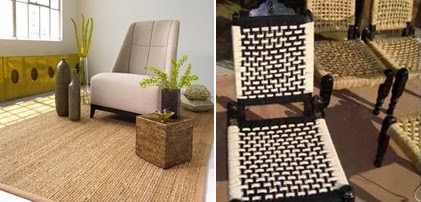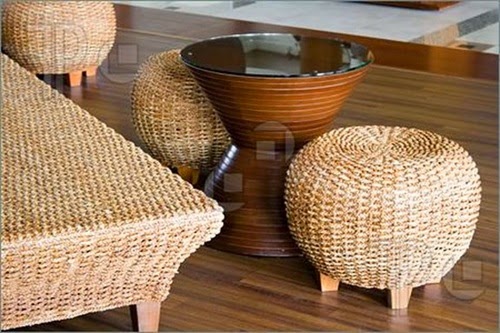Properties of Jute Fiber:
- Jute fibre is 100% bio-degradable and recyclable and thus environmentally friendly.
- Jute is a natural fibre with golden and silky shine and hence called The Golden Fibre.
- Jute is the cheapest vegetable fibre procured from the bast or skin of the plant's stem.
- It is the second most important vegetable fibre after cotton, in terms of usage, global consumption, production, and availability.
- It has high tensile strength, low extensibility, and ensures better breathability of fabrics. Therefore, jute is very suitable in agricultural commodity bulk packaging.
- It helps to make best quality industrial yarn, fabric, net, and sacks. It is one of the most versatile natural fibres that has been used in raw materials for packaging, textiles, non-textile, construction, and agricultural sectors. Bulking of yarn results in a reduced breaking tenacity and an increased breaking extensibility when blended as a ternary blend.
- Unlike the fiber known as hemp, jute is not a form of (Cannabis). Therefore it can be much more easily distinguished from forms of Cannabis that produce a narcotic
- Jute is one of the most versatile natural fibres that has been used in raw materials for packaging, textiles, non-textile, and agricultural sectors.
- Jute stem has very high volume of cellulose that can be procured within 4-6 months, and hence it also can save the forest and meet cellulose and wood requirement of the world.
- The best varieties of Jute are Bangla Tosha - Corchorus olitorius (Golden shine) and Bangla White - Corchorus capsularis (Whitish Shine), and Mesta or Kenaf (Hibiscus cannabinus) is another species with fibre similar to Jute with medium quality.
- Raw Jute and Jute goods are interpreted as Burlap, Industrial Hemp, and Kenaf in some parts of the world.
Uses of Jute Fiber
Jute is the second most important vegetable fibre after cotton; not only for cultivation, but also for various uses.
- Jute is used chiefly to make cloth for wrapping bales of raw cotton, and to make sacks and coarse cloth.
- The fibres are also woven into curtains, chair coverings, carpets, area rugs, hessian cloth, and backing for linoleum.
- While jute is being replaced by synthetic materials in many of these uses, some uses take advantage of jute's biodegradable nature, where synthetics would be unsuitable.
- Jute butts, the coarse ends of the plants, are used to make inexpensive cloth.
- Traditionally jute was used in traditional textile machineries as textile fibres having cellulose (vegetable fibre content) and lignin (wood fibre content). But, the major breakthrough came when the automobile, pulp and paper, and the furniture and bedding industries started to use jute and its allied fibres with their non-woven and composite technology to manufacture nonwovens, technical textiles, and composites.
- Jute can be used to create a number of fabrics such as Hessian cloth, sacking, scrim, carpet backing cloth (CBC), and canvas.
- Hessian, lighter than sacking, is used for bags, wrappers, wall-coverings, upholstery, and home furnishings.
- Sacking, a fabric made of heavy jute fibres, has its use in the name.
- Diversified jute products are becoming more and more valuable to the consumer today. Among these are espadrilles, floor coverings, home textiles, high performance technical textiles, Geotextiles, composites, and more.
- Jute is also used in the making of ghillie suits which are used as camouflage and resemble grasses or brush
Another diversified jute product is Geotextiles, which made this agricultural commodity more popular in the agricultural sector. It is a lightly woven fabric made from natural fibres that is used for soil erosion control, seed protection, weed control, and many other agricultural and landscaping uses. The Geotextiles can be used more than a year and the bio-degradable jute Geotextile left to rot on the ground keeps the ground cool and is able to make the land more fertile.










10 comments:
Your Post is very useful, I am truly happy to post my note on this blog . It helped me with ocean of awareness i really appreciate it.
burlap bags
Nice Blog!!I really Appreciate your Work It Helpful For me it provide useful Information thanks for Posting Keep Posting Good Blogs
Jute Bags
Eco Friendly Jute Bags
Amazing content thanks for the article
Fashion dresses in Tirupur
Jute Products Manufacturer Kissan Jute Craft
I have a technical question from Jute expert. Our company has large warehouses for Rice storage (in Jute Bags). We also do fumigation during storage for long period of time. We are facing burning of jute bags even from the center of stack. Burn is like in straight line of 3 inches to 10 inches of burn in jute bag. Can anyone know about this issue and solution.
Thanks &
Thank you for sharing this post. Very well organized and informative content. Would love to read more posts like this. Here is another content like it Jute Carpet Backing Cloth.
Nice article on jute fiber. Thanks
Jute Worldwide is your one-stop shop if you're seeking a trusted cotton jute shopping bag and braided bag manufacturer in Delhi, India. Growth is a result of recurring business, which is a result of relationships with clients, which are based on trust. Visit Order –
Trusted Cotton Jute Shopping Bags & Braided Bags Manufacturer
Prestige Dew Drops Whitefield Bangalore is a residential project situated at the finest location. Available best floor plan 1 BHK, 2 BHK, and 3 BHK residential dwells.
Visit Here:- Prestige Dew Drops
Post a Comment